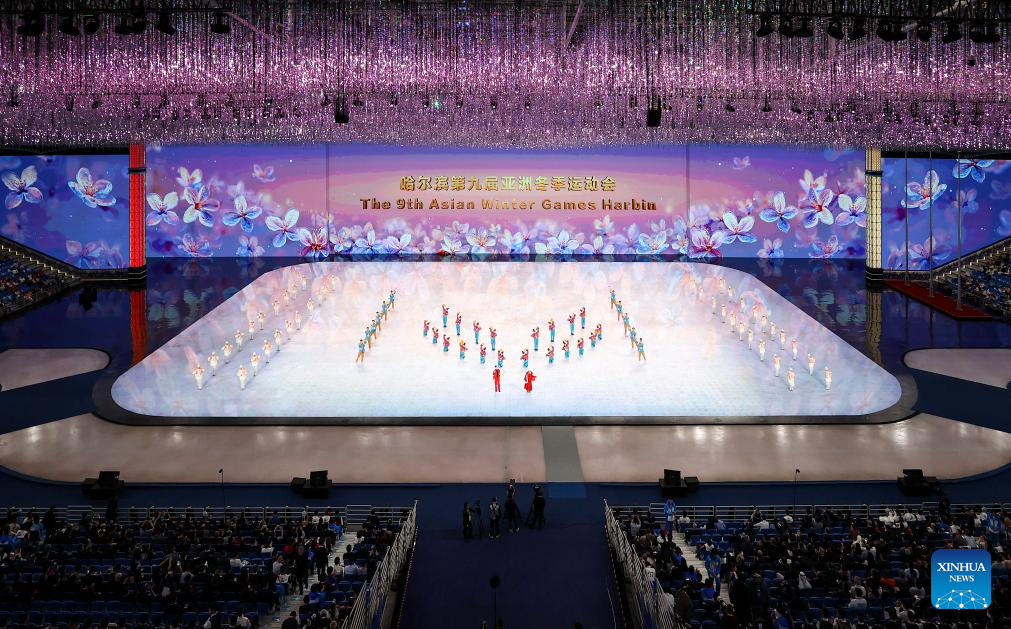
The 9th Asian Winter Games, which opened in Harbin, Heilongjiang province, on Friday, is likely to see China's outstanding performance in the events because the country ranked third in the medal tally in the 2022 Winter Olympic Games.
China has come a long way in becoming a force in winter sports. China's northern regions provide an ideal setting for winter sports because of the massive snow cover during winter.
The temperate climate in southern China may have made people believe that winter sports are suitable only for the north. This was true when China decided to make a breakthrough in winter sports four decades ago, because it started with skating and, not surprisingly, 90 percent of the national team members were from the north, especially from Northeast China.
READ MORE: Chinese firms embrace new opportunities in ice, snow economy
For decades, Chinese athletes have been winning medals in Asian and international winter games in speed skating and figure skating. But they soon found they could not increase their medal tally because they were too weak in skiing, and very few people were taking part in winter sports.
That reality largely prompted China to apply to host the Winter Olympic Games in 2022 to not only try and win more medals as the host country but also encourage more people to take part in ice and snow sports. When applying to host the Winter Olympics, China worked out an ambitious plan to increase the number of people taking part in winter sports from a few million to 300 million within a few years.
Recent data show that, boosted by China's successful hosting of the Winter Olympics, a winter sports fever is spreading across China, including South China, and more than 313 million people are taking part in ice skating, skiing or have become avid winter sports fans. China today has more than 3,300 winter sports venues with over 30 percent of them being skiing facilities. The number is increasing by double digits every year.
The popularity of winter sports has given birth to a new industry. The cold northern regions such as Beijing, Hebei, Jilin, Heilongjiang and Xinjiang are likely to collect millions even billions of yuan as entrance and service fees this season. More factories have been set up to produce winter sports gear and equipment. A State Council document published recently says that the winter sports industry is likely to be worth 1.2 trillion yuan before 2027.
But to make winter sports development sustainable, a lot more needs to be done.
The skiing venues are usually deep in the mountains, far from city centers. It can be dangerous and time-consuming to drive to such venues in poor weather conditions. As such, special trains should be designated to and from such venues, and highways leading to them should be well maintained to ensure skiers and speed skaters reach there safely.
ALSO READ: Competitive spirit and rational fandom define true sports culture
The entrance fees to the skiing venues range from 200 yuan to 800 yuan. Add to that the cost of transportation, accommodation, equipment renting and coaching and the cost could reach a couple of thousand yuan for just one visit. Hence, measures should be taken to reduce the cost of skiing and ice skating. This can be done by building more venues, leading to competitions among the operators. Government watchdogs, on their part, should check the entry and other prices carefully to prevent operators from making excessive profits in the name of developing winter sports.
Besides, the number of entries to the venues should be controlled at "hot" skating and skiing venues, in order to ensure consumers have better training experience and can avoid potential dangers and injuries. The venues should also have good medical equipment and qualified doctors to treat injured athletes and amateur learners.
Only when the above problems are addressed can we turn millions of potential winter sports fans into trained athletes and build a strong talent pool that will help China excel in regional and international winter games.
The author is former deputy editor-in-chief of China Daily.


